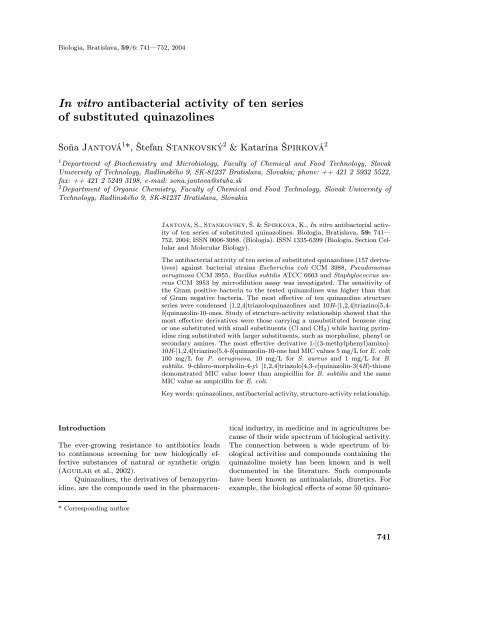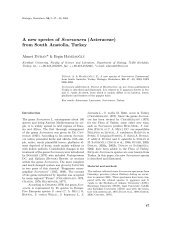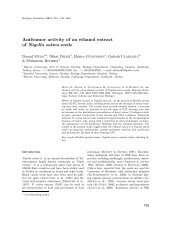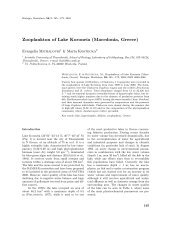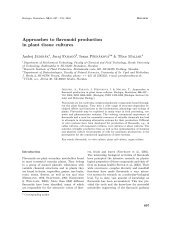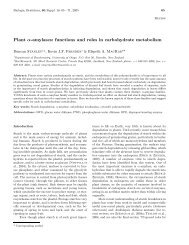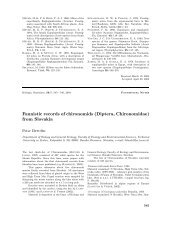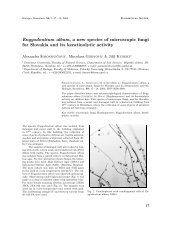In vitro antibacterial activity of ten series of substituted quinazolines
In vitro antibacterial activity of ten series of substituted quinazolines
In vitro antibacterial activity of ten series of substituted quinazolines
Create successful ePaper yourself
Turn your PDF publications into a flip-book with our unique Google optimized e-Paper software.
Biologia, Bratislava, 59/6: 741—752, 2004<br />
<strong>In</strong> <strong>vitro</strong> <strong>antibacterial</strong> <strong>activity</strong> <strong>of</strong> <strong>ten</strong> <strong>series</strong><br />
<strong>of</strong> <strong>substituted</strong> <strong>quinazolines</strong><br />
Soňa Jantová 1 *, Štefan Stankovský 2 & Katarína Špirková 2<br />
1 Department <strong>of</strong> Biochemistry and Microbiology, Faculty <strong>of</strong> Chemical and Food Technology, Slovak<br />
University <strong>of</strong> Technology, Radlinského 9, SK-81237 Bratislava, Slovakia; phone: ++ 421 2 5932 5522,<br />
fax: ++ 421 2 5249 3198, e-mail: sona.jantova@stuba.sk<br />
2 Department <strong>of</strong> Organic Chemistry, Faculty <strong>of</strong> Chemical and Food Technology, Slovak University <strong>of</strong><br />
Technology, Radlinského 9, SK-81237 Bratislava, Slovakia<br />
<strong>In</strong>troduction<br />
The ever-growing resistance to antibiotics leads<br />
to continuous screening for new biologically effective<br />
substances <strong>of</strong> natural or synthetic origin<br />
(AGUILAR et al., 2002).<br />
Quinazolines, the derivatives <strong>of</strong> benzopyrimidine,<br />
are the compounds used in the pharmaceu-<br />
* Corresponding author<br />
JANTOVÁ, S.,STANKOVSKÝ, Š.&ŠPIRKOVÁ, K.,<strong>In</strong> <strong>vitro</strong> <strong>antibacterial</strong> <strong>activity</strong><br />
<strong>of</strong> <strong>ten</strong> <strong>series</strong> <strong>of</strong> <strong>substituted</strong> <strong>quinazolines</strong>. Biologia, Bratislava, 59: 741—<br />
752, 2004; ISSN 0006-3088. (Biologia). ISSN 1335-6399 (Biologia. Section Cellular<br />
and Molecular Biology).<br />
The <strong>antibacterial</strong> <strong>activity</strong> <strong>of</strong> <strong>ten</strong> <strong>series</strong> <strong>of</strong> <strong>substituted</strong> <strong>quinazolines</strong> (157 derivatives)<br />
against bacterial strains Escherichia coli CCM 3988, Pseudomonas<br />
aeruginosa CCM 3955, Bacillus subtilis ATCC 6663 and Staphylococcus aureus<br />
CCM 3953 by microdilution assay was investigated. The sensitivity <strong>of</strong><br />
the Gram positive bacteria to the tested <strong>quinazolines</strong> was higher than that<br />
<strong>of</strong> Gram negative bacteria. The most effective <strong>of</strong> <strong>ten</strong> quinazoline structure<br />
<strong>series</strong> were condensed [1,2,4]triazolo<strong>quinazolines</strong> and 10H-[1,2,4]triazino[5,4b]quinazolin-10-ones.<br />
Study <strong>of</strong> structure-<strong>activity</strong> relationship showed that the<br />
most effective derivatives were those carrying a un<strong>substituted</strong> benzene ring<br />
or one <strong>substituted</strong> with small substituents (Cl and CH3) while having pyrimidine<br />
ring <strong>substituted</strong> with larger substituents, such as morpholine, phenyl or<br />
secondary amines. The most effective derivative 1-[(3-methylphenyl)amino]-<br />
10H-[1,2,4]triazino[5,4-b]quinazolin-10-one had MIC values 5 mg/L for E. coli;<br />
100 mg/L for P. aeruginosa, 10 mg/L for S. aureus and 1 mg/L for B.<br />
subtilis. 9-chloro-morpholin-4-yl [1,2,4]triazolo[4,3-c]quinazolin-3(4H)-thione<br />
demonstrated MIC value lower than ampicillin for B. subtilis and the same<br />
MIC value as ampicillin for E. coli.<br />
Key words: <strong>quinazolines</strong>, <strong>antibacterial</strong> <strong>activity</strong>, structure-<strong>activity</strong> relationship.<br />
tical industry, in medicine and in agricultures because<br />
<strong>of</strong> their wide spectrum <strong>of</strong> biological <strong>activity</strong>.<br />
The connection between a wide spectrum <strong>of</strong> biological<br />
activities and compounds containing the<br />
quinazoline moiety has been known and is well<br />
documented in the literature. Such compounds<br />
have been known as antimalarials, diuretics. For<br />
example, the biological effects <strong>of</strong> some 50 quinazo-<br />
741
Tab. 7<br />
Tab.4<br />
X<br />
Tab. 2 Tab.1 Tab. 3 Tab.6<br />
N R<br />
N<br />
NH<br />
X R´ X X<br />
Y<br />
Y<br />
X<br />
N R<br />
N<br />
X<br />
O<br />
O R´<br />
N<br />
NH<br />
Y<br />
N<br />
N<br />
N<br />
N N<br />
Tab. 5<br />
R<br />
R<br />
Z<br />
Figure 1. Survey <strong>of</strong> compounds studied in this work.<br />
N<br />
X<br />
R<br />
N<br />
N<br />
N<br />
N<br />
R<br />
N NH<br />
Tab.8<br />
line alkaloids occurring in nature were described<br />
in the Armarego monographs (ARMAREGO, 1967,<br />
1979). Up to 1980 several review articles, devoted<br />
to biological phytoeffects and pharmacological research<br />
<strong>of</strong> <strong>quinazolines</strong>, were writ<strong>ten</strong> (JACHONTOV<br />
et al., 1977; JOHNE, 1981; SUESSE & JOHNE,<br />
1981). Due to an unprecedented interest in pharmacologically<br />
utilizable <strong>quinazolines</strong>, in the last<br />
two decades more than one thousand <strong>quinazolines</strong>,<br />
quinazolones, their thioanalogues and condensed<br />
<strong>quinazolines</strong> have been synthesized.<br />
<strong>In</strong> our search for <strong>antibacterial</strong> agents, we have<br />
focused on synthesis and developing <strong>of</strong> quinazoline<br />
derivatives, which may inhibit bacterial growth<br />
(BODAJLA et al., 1994; JANTOVÁ et al., 1994a,b,<br />
1995, 1999, 2000). Our studies, investigating the<br />
relations between the structure <strong>of</strong> <strong>quinazolines</strong> and<br />
their cytotoxic effect on HeLa cells (JANTOVÁ et<br />
al., 1997), have shown that during the experiment<br />
some structural types <strong>of</strong> the tested <strong>quinazolines</strong><br />
are considerably metabolized. The speed <strong>of</strong> the<br />
process does not depend on the lipophilicity <strong>of</strong> the<br />
various substances but on their structure.<br />
<strong>In</strong> this work we summarized the antibacte-<br />
742<br />
Y<br />
N R<br />
N<br />
HN R´<br />
X<br />
N<br />
N<br />
N<br />
N<br />
R<br />
N<br />
N<br />
N N<br />
N<br />
N<br />
O HN R<br />
N<br />
N NH<br />
N<br />
N<br />
N NH<br />
Tab. 9<br />
R<br />
R<br />
O<br />
O<br />
Tab. 10<br />
Tab. 10<br />
rial <strong>activity</strong> <strong>of</strong> 157 <strong>antibacterial</strong> compounds containing<br />
the quinazoline skeleton (Fig. 1), prepared<br />
in our laboratories. We studied both <strong>quinazolines</strong><br />
and quinazolin-4-ones, as well as their sulfur<br />
analogs, <strong>substituted</strong> in positions 2, 3 and 4<br />
<strong>of</strong> the pyrimidine ring and at the benzene ring<br />
<strong>of</strong> quinazoline by typical pharmacophores, such<br />
as halogens, nitro and amino containing groups<br />
and their derivatives, e.g. arylhydrazones and<br />
arylthiosemicarbazones. <strong>In</strong> addition to <strong>substituted</strong><br />
<strong>quinazolines</strong>, we investigated also linearly and angularly<br />
fused <strong>quinazolines</strong>, such as for instance<br />
derivatives <strong>of</strong> 1,2,4-triazolo[4,3-c]<strong>quinazolines</strong>, 3,4dihydro-2H-[1,2,4]triazino[4,3-c]quinazolones<br />
and<br />
10H-[1,2,4]triazino-[5,4-b]<strong>quinazolines</strong>. Further<br />
-more we investigated the relationship between the<br />
<strong>antibacterial</strong> effect and the structure <strong>of</strong> quinazoline<br />
derivative tested.<br />
Material and methods<br />
Bacteria<br />
Escherichia coli CCM 3988, Pseudomonas aeruginosa<br />
CCM 3955, Bacillus subtilis ATCC 6663 and Staphy-
Table 1. Antibacterial effect <strong>of</strong> 2-<strong>substituted</strong> quinazoline-4(3H)-ones and their thio analogues. a<br />
X<br />
N<br />
Y<br />
NH<br />
R<br />
No. X Y R E. coli P. aeruginosa S. aureus B. subtilis<br />
1 H O Phenyl >100 b >100 b >100 b >100 b<br />
2 6-Cl O Phenyl >100 b >100 b 100 b * >100 b<br />
3 H O H >100 b >100 b >100 b >100 b<br />
4 H S Phenyl >100 b >100 b 100 b * >100 b<br />
5 8-CH3 S Phenyl >100 b >100 b >100 b >100 b<br />
6 6-Br S Phenyl >100 b >100 b 100 b * >100 b<br />
7 6-Cl S Phenyl >100 b >100 b 100 b * >100 b<br />
8 6-Br S Morpholin-4-yl >100 b >100 b >100 b >100 b<br />
9 6-Cl S Morpholin-4-yl >100 b >100 b 100 b * >100 b<br />
10 6-Cl S Piperidin-1-yl >100 b >100 b >100 b >100 b<br />
11 6-NO2 S Piperidin-1-yl >100 b >100 b >100 b >100 b<br />
12 6-Cl S 4-Phenylpiperazin-1-yl >100 b >100 b 100 b * >100 b<br />
13 H S N,N-Diphenylamine >100 b >100 b >100 b >100 b<br />
14 H O CH3 >500 c >500 c >500 c >500 c<br />
15 H O CH2Br 100 c * >500 c 100 c * 100 c *<br />
16 H O CH2-morpholin-4-yl >500 c >500 c >500 c >500 c<br />
17 H O CH2-piperidin-1-yl >500 c >500 c >500 c >500 c<br />
18 H O CH2-methoxy >500 c >500 c >500 c >500 c<br />
19 H O CH2-ethoxy >500 c >500 c >500 c >500 c<br />
20 H O CH2-isopropoxy >500 c >500 c >500 c >500 c<br />
21 H O CH2-butoxy >500 c >500 c >500 c >500 c<br />
22 H O CH2-phenoxy >500 c >500 c >500 c >500 c<br />
23 H O CH2-4-nitrophenoxy >500 c >500 c >500 c >500 c<br />
24 H O CH2-2-nitrophenoxy >500 c >500 c >500 c >500 c<br />
25 H O CH2-N,N-dimethylamino >500 c >500 c >500 c >500 c<br />
26 H O CH2-N-(2-hydroxyethyl)amino >500 c >500 c >500 c >500 c<br />
27 H O CH2-N-(methoxycarbonyl) methylamino >500 c >500 c >500 c >500 c<br />
28 H O CH2-N-(1,3-dicarboxypropyl)amino >500 c >500 c >500 c >500 c<br />
29 H O CH2-NH-phenyl >100 >100 >100 >100<br />
30 H O CH2-NH-4-methylphenyl >100 >100 >100 >100<br />
31 H O CH2-NH-4-trifluoromethylphenyl >100 >100 >100 >100<br />
32 H O CH2-NH-2-methoxyphenyl >100 >100 >100 >100<br />
33 H O CH2-NH-2-fluorophenyl >100 >100 >100 >100<br />
34 H O CH2-NH-4-bromophenyl >100 >100 >100 >100<br />
35 H O CH2-NH-4-chlorophenyl >100 >100 >100 >100<br />
36 H O CH2-NH-2,4-dichlorophenyl >100 >100 10** >100<br />
37 H O CH2-NH-2,5- dichlorophenyl >100 >100 >100 >100<br />
38 H O CH2-NH-3,4-dichlorophenyl >100 >100 >100 >100<br />
39 H O CH2-NH-2,3,4-trichlorophenyl >100 >100 >100 >100<br />
40 H O CH2-NH-2-carboxyphenyl >100 >100 >100 >100<br />
41 H O CH2-NH-4-carboxyphenyl >100 >100 >100 >100<br />
42 H O CH2-NH-NH-CS-NH-phenyl >100 >100 >100 >100<br />
43 H O CH2-NH-NH-CS-NH-chlorophenyl >100 >100 >100 >100<br />
44 H O CH2-NH-NH-CS-NH-nitrophenyl >100 >100 >100 >100<br />
45 H O CH2-NH-NH-CS-NH-hydroxyphenyl >100 >100 >100 >100<br />
46 H O CH2-NH-NH-CS-NH-methylphenyl >100 >100 >100 >100<br />
47 H O CH2-NH-NH-CS-NH-izopropyl >100 >100 >100 >100<br />
Amp 1** >100 0.04** 10**<br />
a Values <strong>of</strong> MIC are in mg/L; Amp-ampicillin; ** bactericidal effect, * bacteriostatic effect.<br />
b Reported in JANTOVÁ et al. (2000). c Reported in ŠPIRKOVÁ et al. (1999).<br />
743
Table 2. Antibacterial <strong>activity</strong> <strong>of</strong> 2,3-di<strong>substituted</strong> quinazoline-4(3H)-ones, resp. thiones. a<br />
X<br />
N<br />
Y<br />
NH<br />
R<br />
No. Y R R’ E. coli b P. aeruginosa b S. aureus b B. subtilis b<br />
48 O H COOEt >100 >100 >100 >100<br />
49 O Methyl COOMe >100 >100 >100 >100<br />
50 O Phenyl CH2COOEt >100 >100 >100 >100<br />
51 O H COOEt >100 >100 >100 >100<br />
52 O Methyl COCH2Cl >100 >100 >100 50*<br />
53 O Phenyl COOMe >100 >100 >100 >100<br />
54 S H – >100 >100 >100 >100<br />
55 S Phenyl – >100 >100 >100 50*<br />
56 S Methyl – >100 >100 >100 >100<br />
Amp 1** >100 0.04** 10**<br />
a Values <strong>of</strong> MIC are in mg/L; Amp-ampicillin; ** bactericidal effect, * bacteriostatic effect.<br />
b Reported in JANTOVÁ et al. (1999).<br />
lococcus aureus CCM 3953 were used. All the strains<br />
were obtained from the Czech Collection <strong>of</strong> Microorganisms<br />
(Brno, Czech Republic).<br />
Compounds<br />
The preparation <strong>of</strong> compounds 1–157 has been described<br />
by STANKOVSKÝ et al. (1980, 1989, 1991) and<br />
ŠPIRKOVÁ et al. (1990, 1993, 1994, 1997, 1999). The<br />
compounds were used at concentrations <strong>of</strong> 100, 50, 25,<br />
10, 5, 1 and 0.1 mg/L for compounds 1–13, 29–56, 96–<br />
138 and 156–157; 500, 200, 100, 50, 10, 1 and 0.1 for<br />
compounds 14–28, 76–95 and 139–146; and 1000, 500,<br />
100, 50, 10, 5, 1 and 0.1 mg/L for compounds 57–75<br />
and 147–155. Chromatographically purified derivatives<br />
were dissolved in dimethyl sulfoxide whose final concentration<br />
never exceeded 1% (V/V) in either control<br />
or treated samples. Because the solubility <strong>of</strong> the studied<br />
<strong>quinazolines</strong> covered a wide range, they were tested<br />
in various concentration ranges.<br />
Detection <strong>of</strong> <strong>antibacterial</strong> <strong>activity</strong><br />
The <strong>antibacterial</strong> effect was assayed by a microdilution<br />
method in 96-well microtitration plates (JANTOVÁ<br />
et al., 1995). The bacteria were cultured on Müller-<br />
Hinton medium at 30 ◦ C. An overnight inoculum was<br />
prepared 12–16 h before the test. The growing inoculum<br />
was filtered and a 1.5% suspension <strong>of</strong> bacteria was<br />
prepared for the experiments. This suspension (180<br />
µL) was added to 20 µL <strong>of</strong> the tested complex solution<br />
and cultured for 8 h on a reciprocal shaker in a thermostat<br />
at 30 ◦ C. The time course <strong>of</strong> absorbance (A630)<br />
was then determined in three parallels. To compare<br />
the <strong>antibacterial</strong> <strong>activity</strong>, ampicillin at concentrations<br />
100, 10, 1, 0.1 and 0.01 mg/L was used as standard.<br />
The <strong>antibacterial</strong> effect was characterized by IC50 values,<br />
i.e. the minimal inhibition concentration <strong>of</strong> a substance<br />
which inhibits bacterial growth by 50% relative<br />
to the control, and MIC, i.e. the minimal inhibitory<br />
744<br />
concentration <strong>of</strong> a substance which inhibits the bacterial<br />
growth by 100%. The IC50 and MIC values were<br />
determined from toxicity curves.<br />
Results<br />
The results obtained in the <strong>antibacterial</strong> tests<br />
are summarized in Tables 1–10. Table 1 represents<br />
the <strong>antibacterial</strong> effect <strong>of</strong> the <strong>substituted</strong><br />
quinazoline-4(3H)-ones and their thioanalogues.<br />
The sensitivity <strong>of</strong> Gram positive bacteria to the<br />
above-mentioned derivatives was higher than that<br />
<strong>of</strong> Gram negative bacteria. The bacterium S.<br />
aureus was the higher sensitive to <strong>substituted</strong><br />
quinazoline-4(3H)-ones and their thioanalogues.<br />
MIC values show that the <strong>antibacterial</strong> effect was<br />
found with derivatives 2, 4, 6, 7, 9, 12, 15 and 36.<br />
Derivatives2,4,6,7,9,12and36wereactive<br />
against S. aureus. Only derivative 15 was effective<br />
against Gram positive S. aureus, B. subtilis and<br />
Gram negative E. coli. A concentration 100 mg/L<br />
<strong>of</strong> quinazoline 15 caused bacteriostatic effect. A<br />
concentration 10 mg/L <strong>of</strong> quinazoline 36 exerted<br />
a bactericidal effect on S. aureus. The other <strong>substituted</strong><br />
quinazoline-4(3H)-ones and their thioanalogues<br />
tested were inactive.<br />
Table 2 shows the MIC values <strong>of</strong> nine 2,3di<strong>substituted</strong><br />
quinazoline-4(3H)-ones and thiones.<br />
Only the bacterium B. subtilis was sensitive to<br />
the effects <strong>of</strong> two <strong>quinazolines</strong>. A concentration 50<br />
mg/L <strong>of</strong> <strong>quinazolines</strong> 52, 55 induced bacteriostatic<br />
effect on B. subtilis. No <strong>antibacterial</strong> <strong>activity</strong> was<br />
found with other 2,3-di<strong>substituted</strong> quinazoline-<br />
4(3H)-ones and thiones.
Table 3. Antibacterial <strong>activity</strong> <strong>of</strong> (a) 4-quinazolylhydrazines and their arylhydrazones and (b) 4-quinazolylthiosemicarazides.<br />
a<br />
X<br />
(a)<br />
N R<br />
N<br />
HN R´<br />
No. X R R’ E. coli b P. aeruginosa b S. aureus b E. faecalis b<br />
57 6-Cl Morpholin-4-yl NH2 >1000 >1000 >1000 >1000<br />
58 6-Cl Piperidin-1-yl NH2 >1000 500** >1000 500*<br />
59 6-Cl Phenyl NH2 500** >1000 500** 250**<br />
60 6-Br Morpholin-4-yl NH2 500* >1000 250** >1000<br />
61 H Piperidin-1-yl NH2 >1000 >1000 250** >1000<br />
62 H Phenyl NH2 >1000 1000* 500** >1000<br />
63 8-CH3 Morpholin-4-yl NH2 1000* >1000 1000* 500*<br />
64 8-CH3 Phenyl NH2 1000* 250* 94* 1000*<br />
65 6-Cl Morpholin-4-yl N=CH-2-furyl >1000 >1000 >1000 >1000<br />
66 6-Cl Morpholin-4-yl N=CH-4-nitrophenyl >1000 >1000 >1000 >1000<br />
67 6-Cl Morpholin-4-yl N=CH-2-nitrophenyl >1000 >1000 >1000 >1000<br />
68 6-Cl Morpholin-4-yl N=CH-2-chlorophenyl >1000 >1000 >1000 >1000<br />
69 6-Cl Morpholin-4-yl N=CH-4-acetamidophenyl >1000 >1000 >1000 >1000<br />
70 6-Cl Morpholin-4-yl N=CH-5-bromo-2-furyl 1000* >1000 >1000 >1000<br />
71 6-Cl Morpholin-4-yl N=CH-5-nitro-2-furyl 500* 500* 250** 100**<br />
72 8-CH3 Phenyl 2-furyl >1000 >1000 >1000 1000<br />
73 8-CH3 Phenyl N=CH-phenyl 1000* 1000* >1000 >1000<br />
74 8-CH3 Phenyl N=CH-4-N, 500* 500* 500* 500*<br />
N-dimethylaminophenyl<br />
75 8-CH3 Phenyl N=CH-4-nitrophenyl >1000 >1000 >1000 >1000<br />
Amp 1** >500 0,04** 1**<br />
(b)<br />
No. X R R’ E. coli c P. aeruginosa c S. aureus c B. subtilis c<br />
76 6-Cl Phenyl NH-CS-NH-phenyl >200 >200 >200 >200<br />
77 6-Cl Morpholin-4-yl NH-CS-NH-phenyl >200 >200 >200 >200<br />
78 6-Cl Piperidin-1-yl NH-CS-NH-phenyl >200 >200 >200 >200<br />
79 6-Cl 4-N-Phenylpiperidin-1yl NH-CS-NH-phenyl >200 >200 >200 >200<br />
80 8-CH3 Phenyl NH-CS-NH-phenyl 10-100 10-100 10-100 10-100<br />
81 8-CH3 Phenyl NH-CS-NH-(4-NO2-phenyl) 10** >200 >200 1*<br />
82 6-Cl N,N-Diethylamine NH-CS-NH-phenyl >200 >200 >200 >200<br />
83 6-Br Morpholin-4-yl NH-CS-NH-phenyl >200 >200 >200 >200<br />
Amp 1** >500 0.04** 10**<br />
a Values <strong>of</strong> MIC are in mg/L; Amp-ampicillin; ** bactericidal effect, * bacteriostatic effect.<br />
b Reported in JANTOVÁ et al. (1995).<br />
c Reported in JANTOVÁ et al. (1994b).<br />
The <strong>activity</strong> <strong>of</strong> 4-quinazolylhydrazines, their<br />
arylhydrazones and 4-quinazolylthiosemicarbazides<br />
is demonstrated in Table 3. The broadest <strong>antibacterial</strong><br />
effect was found with derivatives 64, 71,<br />
74 and 80 which were effective with all the tested<br />
bacteria. No <strong>antibacterial</strong> <strong>activity</strong> was found with<br />
derivatives 57, 65, 66, 67, 68, 69, 75, 76, 77, 78,<br />
79, 82 and 83. The sensitivity <strong>of</strong> Gram positive<br />
bacteria to the derivatives was higher than that <strong>of</strong><br />
Gram negative bacteria.<br />
Antibacterial <strong>activity</strong> <strong>of</strong> 2,6-di<strong>substituted</strong> 4anilino<strong>quinazolines</strong><br />
is demonstrated in Table 4.<br />
None <strong>of</strong> the prepared <strong>quinazolines</strong> influenced the<br />
Gram negative E. coli and P. aeruginosa. The<br />
widest <strong>antibacterial</strong> spectrum was encountered<br />
with 4-anilino<strong>quinazolines</strong> 92 and 93 which were<br />
745
Table 4. Antibacterial <strong>activity</strong> <strong>of</strong> 2,6-di<strong>substituted</strong> 4-anilino<strong>quinazolines</strong>. a<br />
X<br />
N R<br />
HN<br />
N<br />
Y<br />
No. X R Y E. coli b P. aeruginosa b S. aureus b B. subtilis b<br />
84 6-Br 2-Diethylamino 4’-NO2 >500 >500 >500 10500 >500 >500<br />
86 6-Br 2-Morpholin-4-yl 4’-Br >500 >500 >500 >500<br />
87 6-Br 2-Morpholin-4-yl 2’-NO2 >500 >500 >500 >500<br />
88 6-Br 2-Morpholin-4-yl 4’-NO2 >500 >500 >500 >500<br />
89 6-Br 2-Morpholin-4-yl H >500 >500 >500 >500<br />
90 H Morpholin-4-yl 4’-Br >500 >500 >500 >500<br />
91 6-Cl Morpholin-4-yl 4’-NO2 >500 >500 >500 >500<br />
92 H Phenyl H >500 >500 10** 10500 1500<br />
95 6-Cl Phenyl 4’-CH3 >500 >500 >500 >500<br />
Amp 1** >500 0.04** 10**<br />
a Values <strong>of</strong> MIC are in mg/L; Amp-ampicillin; ** bactericidal effect, * bacteriostatic effect.<br />
b Reported in JANTOVÁ et al. (1994a).<br />
Table. 5 Antibacterial <strong>activity</strong> <strong>of</strong> some [1,2,4]triazolo[4,3-c]<strong>quinazolines</strong>. a<br />
X<br />
N R<br />
N<br />
N<br />
N<br />
Z<br />
No. X R Z E. coli P. aeruginosa S. aureus B. subtilis<br />
96 9-Cl Morpholin-4-yl NH-phenyl 10–100 10–100 10–100 10–100<br />
97 9-Cl Piperidin-1-yl NH-phenyl 10–100 10–100 10–100 10–100<br />
98 9-Cl 4-Phenylpiperazin-1-yl NH-phenyl >200 >200 >200 >200<br />
99 7-Me Phenyl NH-phenyl >200 >200 >200 >200<br />
100 9-Cl Morpholin-4-yl <strong>In</strong>dol-3-yl >100 >100 100** 100**<br />
101 9-Cl Morpholin-4-yl 5-nitrothiophen-2-yll >100 >100 50** 10**<br />
102 9-Cl Morpholin-4-yl 5-nitr<strong>of</strong>uran-2-yl >100 >100 50** 10**<br />
103 9-Cl Morpholin-4-yl 5-phenylsulfonylfuran-2-yl >100 >100 >100 >100<br />
104 9-Cl Morpholin-4-yl 2-acetylfuran-2-yl >100 >100 >100 >100<br />
105 9-Cl Morpholin-4-yl 5-brom<strong>of</strong>uran-2-yl >100 >100 100* 50*<br />
106 9-Cl Morpholin-4-yl 4-acetamidophenyl >100 >100 >100 >100<br />
107 9-Cl Morpholin-4-yl 2-nitrophenyl >100 >100 >100 >100<br />
108 9-Cl Morpholin-4-yl 2-chlorophenyl >100 >100 >100 >100<br />
109 9-Cl 4-Phenylpiperazin-1-yl 4-chlorophenyl >100 >100 >100 >100<br />
110 9-Cl 4-Phenylpiperazin-1-yl 5-nitr<strong>of</strong>uran-2-yl >100 >100 100** 50**<br />
111 9-Cl 4-Phenylpiperazin-1-yl 5-chlor<strong>of</strong>uran-2-yl >100 >100 >100 >100<br />
112 9-Cl 4-Phenylpiperazin-1-yl furan-2-yl >100 >100 >100 >100<br />
113 9-Cl 4-Phenylpiperazin-1-yl 5-brom<strong>of</strong>uran-2-yl >100 >100 >100 >100<br />
114 9-Cl 4-Phenylpiperazin-1-yl phenyl >100 >100 >100 >100<br />
115 9-Cl 4-Phenylpiperazin-1-yl 4-N,N-dimethylaminophenyl >100 >100 >100 >100<br />
Amp 1** >500 0.04** 10**<br />
a Values <strong>of</strong> MIC are in mg/L; Amp-ampicillin; ** bactericidal effect.<br />
746
Table 6. Antibacterial <strong>activity</strong> <strong>of</strong> some 1-(alkyl/aryl-amino)-10H-[1,2,4]triazino[5,4-b] quinazolin-10-ones. a<br />
N<br />
N<br />
N<br />
N<br />
O HN R<br />
No. R E. coli P. aeruginosa S. aureus B. subtilis<br />
116 Phenyl 5* >100 25* 1**<br />
117 4-chlorophenyl 10* >100 100* 5*<br />
118 2-nitrophenyl 5* >100 25* 1*<br />
119 3-hydroxyphenyl >100 >100 >100 >100<br />
120 3-methylphenyl 5* 100* 10* 1**<br />
121 isopropyl 10** >100 25* 1**<br />
Amp 1** >100 0.04** 10**<br />
a Values <strong>of</strong> MIC are in mg/L; Amp-ampicillin; ** bactericidal effect, * bacteriostatic effect.<br />
effective against B. subtilis and S. aureus. Derivative<br />
84 influenced only Gram positiveB. subtilis.<br />
Table 5 shows the <strong>activity</strong> <strong>of</strong> <strong>substituted</strong><br />
1,2,4-triazolo[4,3-c]<strong>quinazolines</strong>. The broadest <strong>antibacterial</strong><br />
spectrum was demonstrated with derivatives<br />
96 and 97 which were effective with all the<br />
tested bacteria. Derivatives 100, 101, 102, 105 and<br />
110 influenced Gram positive S. aureus and B. subtilis.<br />
The MIC values <strong>of</strong> these derivatives exerted<br />
bactericidal effect on Gram positive bacteria. The<br />
effect <strong>of</strong> derivatives 101 and 102 on B. subtilis was<br />
the same as that <strong>of</strong> ampicillin. Minimal inhibition<br />
concentration (10 mg/L) exhibited bactericidal effect.<br />
The MIC values <strong>of</strong> the 10H-[1,2,4]triazino[5,<br />
4-b]quinazolin-10-ones against Gram positive and<br />
Gram negative bacteria is shown in Table 6. Five<br />
derivatives (116, 117, 118, 120, 121) were effective<br />
on the three bacterial strains tested. The highest<br />
<strong>activity</strong> <strong>of</strong> these compounds was against B.<br />
subtilis. A concentration <strong>of</strong> 1 mg/L <strong>of</strong> 118 induced<br />
100% inhibition <strong>of</strong> the bacterial growth.<br />
On the other hand, the concentration <strong>of</strong> derivatives<br />
116, 120 and 121 exhibited bactericidal effect<br />
against B. subtilis. The MIC values for B. subtilis<br />
was 2-times (for derivative 117) and 10-times<br />
(for derivatives 116, 118, 120 and 121) lower than<br />
the corresponding value for ampicillin. Derivative<br />
120 exhibited the highest <strong>antibacterial</strong> <strong>activity</strong><br />
on S. aureus (MIC = 10 mg/L). A certain<br />
<strong>antibacterial</strong> effect on S. aureus was manifested<br />
by derivatives 116, 118, and 121, too (MIC =<br />
25 mg/L). Derivatives 116, 118 and 120 demonstrated<br />
the highest <strong>antibacterial</strong> <strong>activity</strong> on E. coli<br />
(MIC = 5 mg/L). Minimal inhibition concentration<br />
<strong>of</strong> derivative 121 was 10 mg/L and it was<br />
also the concentration which induced bactericidal<br />
effect on E. coli. The least sensitive to the effect<br />
<strong>of</strong> 10H-[1,2,4]triazino[5,4-b]quinazolin-10-ones<br />
was P. aeruginosa. Only derivative 120 exhibited<br />
the total inhibition <strong>of</strong> the growth <strong>of</strong> P. aeruginosa<br />
(MIC = 100 mg/L). Other 10H-[1,2,4]triazino[5,4b]quinazolin-10-ones<br />
were inactive.<br />
ThedatapresentedinTable7showthe<strong>antibacterial</strong><br />
<strong>activity</strong> <strong>of</strong> quinazoline derivatives comprising<br />
amino acid moiety at position 3. All the<br />
test compounds were found to be non-effective.<br />
The MIC values were higher than the highest concentration<br />
tested.<br />
The effect <strong>of</strong> [1,2,4]triazolo<strong>quinazolines</strong> is<br />
summarized in Table 8. The broadest <strong>antibacterial</strong><br />
spectrum was encountered with derivative<br />
142 which was effective with all tested bacteria<br />
(MIC = 10-100 mg/L). Derivative 140 was effective<br />
with the three tested bacteria. It was more active<br />
against S. aureus and E. coli than ampicillin.<br />
Derivative 142 was more active against P. aeruginosa<br />
than ampicillin. S. aureus was found to be<br />
the most sensitive bacterium towards the <strong>quinazolines</strong><br />
presented in Table 8. Derivatives 140, 142,<br />
144 and 145 manifested <strong>antibacterial</strong> <strong>activity</strong> on<br />
S. aureus.<br />
The MIC values <strong>of</strong> tetrazolo[1,5-c]<strong>quinazolines</strong><br />
are given in Table 9. Sensitivity <strong>of</strong> Gram positive<br />
bacteria to the derivatives was higher than<br />
that <strong>of</strong> Gram negative bacteria. Derivative 155<br />
was effective against S. aureus and P. aeruginosa<br />
(MIC= 1000 mg/L). None <strong>of</strong> tetrazolo[1,5c]<strong>quinazolines</strong><br />
influenced E. coli.<br />
The results presented in Table 10 show<br />
the <strong>antibacterial</strong> <strong>activity</strong> <strong>of</strong> the two triazino[4,3c]<strong>quinazolines</strong>.<br />
None <strong>of</strong> them influenced the bacterial<br />
growth (MIC > 100 mg/L).<br />
The data presented in Tables 1–10 imply<br />
747
Table 7. Antibacterial <strong>activity</strong> <strong>of</strong> some 4-oxo<strong>quinazolines</strong> containing amino acid or amino ester moieties. a<br />
N<br />
R O<br />
N<br />
X<br />
O<br />
R´<br />
No. R X R’ E. coli P. aeruginosa S. aureus B. subtilis<br />
122 Methyl -CH2- OH >100 >100 >100 >100<br />
123 Methyl 1,4-(C6H4)- OH >100 >100 >100 >100<br />
124 Phenyl -CH2CH2- OH >100 >100 >100 >100<br />
125 Pheny 1,4-(C6H4)- OH >100 >100 >100 >100<br />
126 Methyl -CH2- NH-CH(COOH)-CH2-CH2-COOH >100 >100 >100 >100<br />
127 Methyl -CH2CH2- NH-CH(COOH)-CH2-CH2-COOH >100 >100 >100 >100<br />
128 Methyl 1,4-(C6H4)- NH-CH(COOH)-CH2-CH2-COOH >100 >100 >100 >100<br />
129 Phenyl 1,4-(C6H4)- NH-CH(COOH)-CH2-CH2-COOH >100 >100 >100 >100<br />
130 Methyl -CH2- CH2-COOH >100 >100 >100 >100<br />
131 Methyl -CH2- CH2CH2-COOH >100 >100 >100 >100<br />
132 Methyl -CH2CH2- CH2-COOH >100 >100 >100 >100<br />
133 Methyl -CH2 NH-CH(COOEt)-CH2-CH2-COOEt >100 >100 >100 >100<br />
134 Methyl 1,4-(C6H4)- NH-CH(COOMe)-CH2-CH2-COOMe >100 >100 >100 >100<br />
135 Phenyl -CH2CH2- NH-CH(COOEt)-CH2-CH2-COOEt >100 >100 >100 >100<br />
136 Phenyl 1,4-(C6H4)- NH-CH(COOMe)-CH2-CH2-COOMe >100 >100 >100 >100<br />
137 H – NH-CH2-COOH >100 >100 >100 >100<br />
138 H – NH-CH2-CH2-COOH >100 >100 >100 >100<br />
Amp 1** >100 0.04** 10**<br />
a Values <strong>of</strong> MIC are in mg/L; Amp-ampicillin; Me = methyl, Et = ethyl;** bactericidal effect.<br />
Table 8. Antibacterial <strong>activity</strong> <strong>of</strong> some 1,2,4-triazolo[4,3-c]quinazoline-3-thiones, resp. 3-ones. a<br />
X<br />
N R<br />
N<br />
N NH<br />
Y<br />
No. X R Y E. coli b P. aeruginosa b S. aureus b B. subtilis b<br />
139 9-Cl Phenyl S >200 >200 >200 >200<br />
140 9-Cl Morpholin-4-yl S 1* >200 0.1–1 0.1–1<br />
141 9-Cl Piperidin-1-yl S >200 >200 >200 >200<br />
142 9-Cl 4-Phenylpiperazin-1-yl S 10–100 10–100 10–100 10–100<br />
143 7-Me Phenyl S >200 >200 >200 >200<br />
144 H H O >100 >100 100 >100<br />
145 H Phenyl O >100 >100 50 >100<br />
146 H Methyl O >100 >100 >100 >100<br />
Amp 1** >100 0.04** 10**<br />
a Values <strong>of</strong> MIC are in mg/L; Amp-ampicillin; ** bactericidal effect, * bacteriostatic effect.<br />
b Reported in JANTOVÁ et al. (1994b).<br />
that, in general, the sensitivity <strong>of</strong> the Gram positive<br />
bacteria to the <strong>quinazolines</strong> tested was higher<br />
than that <strong>of</strong> Gram negative bacteria.<br />
The [1,2,4]triazolo<strong>quinazolines</strong> (Tab. 8) and<br />
10H-[1,2,4]triazino[5,4-b]quinazolin-10-ones<br />
(Tab. 6) were found to be the most effective<br />
among the <strong>quinazolines</strong> tested. The minimal inhibition<br />
concentration <strong>of</strong> five 10H-[1,2,4]triazino[5,4-<br />
748<br />
b]quinazolin-10-ones for B. subtilis was lower<br />
than the corresponding value <strong>of</strong> ampicillin and<br />
was in the range 1–5 mg/L. The MIC values<br />
<strong>of</strong> the most effective derivatives were in the<br />
range <strong>of</strong> 10–100 mg/L for S. aureus and in<br />
the range 5–10 mg/L for E. coli. The most effective<br />
derivative 1-[(3-methylphenyl)amino]-10H-<br />
[1,2,4]triazino[5,4-b]quinazolin-10-one (120) had
Table 9. Antibacterial <strong>activity</strong> <strong>of</strong> some tetrazolo[1,5-c]<strong>quinazolines</strong>. a<br />
X<br />
N R<br />
N<br />
N<br />
N N<br />
No X R E. coli b P. aeruginosa b S. aureus b E. faecalis b<br />
147 H Diphenylamine >1000 >1000 >1000 >1000<br />
148 9-Cl Morpholin-4-yl >1000 >1000 >1000 >1000<br />
149 9-Br Morpholin-4-yl >1000 >1000 >1000 >1000<br />
150 9-Cl Piperidin-1-yl >1000 >1000 >1000 >1000<br />
151 H Morpholin-4-yl >1000 >1000 >1000 >1000<br />
152 H Phenyl >1000 >1000 250* 250*<br />
153 9-Cl Phenyl >1000 >1000 1000* 1000*<br />
154 9-Br Phenyl >1000 >1000 >1000 >1000<br />
155 7-CH3 Phenyl >1000 1000 1000 >1000<br />
Amp 1** >500 0.04** 1**<br />
a Values <strong>of</strong> MIC are in mg/L; Amp-ampicillin; ** bactericidal effect, * bacteriostatic effect.<br />
b Reported in JANTOVÁ et al. (2004).<br />
Table 10. Antibacterial <strong>activity</strong> <strong>of</strong> some triazino[4,3-c]quinazoline-4-ones. a<br />
156<br />
N<br />
N<br />
N NH<br />
R<br />
O<br />
157<br />
N<br />
N<br />
N NH<br />
R<br />
O<br />
No. R E. coli b P. aeruginosa b S. aureus b B. subtilis b<br />
156 Methyl >100 >100 >100 >100<br />
157 Phenyl >100 >100 >100 >100<br />
Amp 1** >100 0.04** 10**<br />
a Values <strong>of</strong> MIC are in mg/L; Amp-ampicillin; ** bactericidal effect.<br />
b Reported in JANTOVÁ et al. (1999).<br />
displayed MIC value <strong>of</strong> 5 mg/L for E. coli, 100<br />
mg/L for P. aeruginosa, 10 mg/L for S. aureus,<br />
and 1 mg/L for B. subtilis.<br />
Among the [1,2,4]triazolo<strong>quinazolines</strong> the<br />
most effective derivatives showed the MIC values<br />
in the range <strong>of</strong> 0.1-100 mg/L for S. aureus<br />
and B. subtilis and 1–100 mg/L for E. coli. The<br />
most effective derivative 9-chloro-morpholin-4-yl<br />
[1,2,4]triazolo[4,3-c]quinazolin-3(4H)-thione (140)<br />
demonstrated the MIC value lower than ampicillin<br />
for B. subtilis and the same MIC value for<br />
E. coli.<br />
The condensed <strong>quinazolines</strong> (120, 140) were<br />
highly effective, too. The MIC values <strong>of</strong> the most<br />
effective <strong>quinazolines</strong> were in the range <strong>of</strong> 0.1-10.0<br />
mg/L and they were higher than those <strong>of</strong> the standard.<br />
Discussion<br />
<strong>In</strong>fectious diseases caused by bacteria affect millions<br />
<strong>of</strong> people worldwide. Concerted and systematic<br />
programs to discover and develop new antibiotics<br />
have been driven to a considerable ex<strong>ten</strong>t by<br />
the development <strong>of</strong> resistance by these organisms<br />
to the drugs commonly used against them.<br />
<strong>In</strong> the present study the <strong>antibacterial</strong> <strong>activity</strong><br />
<strong>of</strong> 157 <strong>substituted</strong> <strong>quinazolines</strong> against bacterial<br />
strains Escherichia coli CCM 3988, Pseudomonas<br />
aeruginosa CCM 3955, Bacillus subtilis<br />
ATCC 6663 and Staphylococcus aureus CCM 3953<br />
by microdilution assay was investigated. The minimum<br />
inhibitory concentration (MIC) <strong>of</strong> the <strong>quinazolines</strong><br />
tested has been determined by a microdilution<br />
method in 96-well microtitration plates.<br />
749
The structure-<strong>activity</strong> relationship has also been<br />
studied. Ten <strong>series</strong> <strong>of</strong> <strong>substituted</strong> <strong>quinazolines</strong><br />
were tested, namely the <strong>substituted</strong> quinazoline-<br />
4(3H)-ones and their thioanalogues (Tab. 1); 2,3di<strong>substituted</strong><br />
quinazoline-4(3H)-ones and thiones<br />
(Tab. 2); 4-quinazolylhydrazines their arylhydrazones<br />
and 4-quinazolylthiosemicarbazides (Tab. 3);<br />
2,6-di<strong>substituted</strong> 4-anilino-<strong>quinazolines</strong> (Tab. 4);<br />
1,2,4-triazolo[4,3-c]<strong>quinazolines</strong> (Tab. 5); 10H-[1,<br />
2,4]triazino[5,4-b]quinazolin-10-ones (Tab. 6); <strong>quinazolines</strong><br />
with aminoacid groups at position 3<br />
(Tab. 7); [1,2,4]triazolo<strong>quinazolines</strong> (Tab. 8); tetrazolo[1,5-c]<br />
<strong>quinazolines</strong> (Tab. 9); and triazino[4,3c]<strong>quinazolines</strong><br />
(Tab. 10).<br />
<strong>In</strong> the first stage <strong>of</strong> the preparation <strong>of</strong> quinazoline<br />
derivatives, simple <strong>quinazolines</strong> were synthesized,<br />
e.g. those <strong>substituted</strong> in positions 2, 3<br />
and 4 <strong>of</strong> the pyrimidine ring, as well as in various<br />
positions <strong>of</strong> the benzene ring by substituents<br />
known as pharmacophores (Tabs 1, 2, 3, 4 and<br />
7). <strong>In</strong> the next stage, condensed <strong>quinazolines</strong> were<br />
prepared and tested (Tabs 5, 6, 8, 9 and 10).<br />
Further five- and six-membered rings containing<br />
several nitrogen atoms were fused with the “b”<br />
or “c” side <strong>of</strong> the pyrimidine ring <strong>of</strong> quinazoline<br />
skeleton in expectation <strong>of</strong> substantial change in<br />
bio<strong>activity</strong>. It turned out, that the most effective<br />
<strong>quinazolines</strong> were condensed [1,2,4]triazolo<strong>quinazolines</strong><br />
(Tab. 8) and 10H-[1,2,4]triazino[5,4b]quinazolin-10-ones<br />
(Tab. 6). Our examination <strong>of</strong><br />
structure-<strong>activity</strong> relationship further showed that<br />
the most effective derivatives were those carrying<br />
an un<strong>substituted</strong> benzene ring or one <strong>substituted</strong><br />
with small substituents (Cl and CH3) while having<br />
pyrimidine ring <strong>substituted</strong> with larger substituents,<br />
such as morpholine, phenyl or secondary<br />
amines. The most effective <strong>quinazolines</strong> had small<br />
molecular size.<br />
The highest antimicrobial <strong>activity</strong> was evoked<br />
by substitution with chloro or methyl groups at<br />
the 4-position <strong>of</strong> the aryl ring <strong>of</strong> <strong>substituted</strong> 4(3H)quinazolone<br />
derivatives synthesized by MISRA et<br />
al.(1982), too.<br />
Similarly KUYPER et al. (1996) found, that<br />
antimicrobial <strong>activity</strong> <strong>of</strong> 7,8-dialkyl-1,3-diaminopyrrolo[3,2-f<br />
]<strong>quinazolines</strong> might be inversely related<br />
to the molecular size <strong>of</strong> the inhibitor.<br />
Their results suggested that relatively small chemical<br />
group would provide optimal interactions<br />
with a hydrophobic region <strong>of</strong> dihydr<strong>of</strong>olate reductase.<br />
BEKHIT et al. (2001) synthesized and evaluated<br />
<strong>antibacterial</strong> and antifungal <strong>activity</strong> <strong>of</strong><br />
new chalcone and sydnone derivatives <strong>of</strong> 4(3H)quinazolinone.<br />
The most po<strong>ten</strong>t compound was<br />
750<br />
derivative with small chemical group – the nitroso<br />
derivative.<br />
Furthermore our results showed that the<br />
Gram positive bacteria were more sensitive that<br />
Gram negative bacteria towards the tested <strong>quinazolines</strong>.<br />
The higher sensitivity <strong>of</strong> Gram positive<br />
bacteria relative to Gram negative bacteria was<br />
proved by ELSLAGER et al. (1978 a,b), KHALIL &<br />
HABIB (1987), BAIOCCHI et al.(1993) and SHIBA<br />
et al. (1997). On the other hand, ABOUSHADY at<br />
al. (1979), ELSLAGER et al. (1984), FARGHALY<br />
et al. (1990) and NASR et al. (2003) reported<br />
that the tested <strong>quinazolines</strong> were active on Gram<br />
positive and Gram negative bacteria. It probably<br />
relates with data, that some <strong>quinazolines</strong> are<br />
species selective inhibitors <strong>of</strong> dihydr<strong>of</strong>olate reductase<br />
(CHAN et al., 1995).<br />
From the preliminary results <strong>of</strong> this study we<br />
could conclude that 1-[(3-methylphenyl)amino]-<br />
10H-[1,2,4] triazino[5,4-b]quinazolin-10-one (120)<br />
and 9-chloro-morpholin-4-yl [1,2,4]triazolo[4,3-c]<br />
quinazolin- 3(4H )-thione (140) are the most active<br />
<strong>antibacterial</strong> agents.<br />
Acknowledgements<br />
This work was supported by the Slovak Grant Agency<br />
VEGA, grants No. 1/1173/04, 1/0058/03 and 1/9254/<br />
02.<br />
References<br />
ABOUSHADY, H.A.,EL-KERDAWY, J.&TAYEL, M.<br />
M. 1979. Synthesis and antimicrobial testing <strong>of</strong><br />
2-<strong>substituted</strong> styryl-6-nitro-4-quinazolones. Pharmazie<br />
34: 805–806.<br />
AGUILAR, L.,GIMENEZ, M. J., GARCIA-REY, C.&<br />
MARTIN, J. E. 2002. New strategies to overcome<br />
antimicrobial resistance in Streptococcus pneumoniae<br />
with beta-lactam antibiotics. Antimicrob.<br />
Chemother. 50 (Suppl. C): 93–100.<br />
ARMAREGO, W. L. F. 1967. Quinazolines. <strong>In</strong>: The<br />
Chemistry <strong>of</strong> Heterocyclic Compounds, Vol. 24/1,<br />
<strong>In</strong>terscience Publisher Ltd., New York, London,<br />
Sydney.<br />
ARMAREGO, W. L. F. 1979. Quinazolines. Advan. Heterocyclic<br />
Chem. 24: 1–62.<br />
BAIOCCHI, L.;GIANNANGELI, M.&ROSSI, V. 1993.<br />
Synthesis and evaluation <strong>of</strong> <strong>substituted</strong> 4(3H)quinazolone<br />
derivatives for antimicrobial and antiacetylcholinesterase<br />
activities. Il Farmaco 4: 487–<br />
501.<br />
BEKHIT, A.A.,HABIB, N.S., EL-DIN, A.&BEKHIT,<br />
A. 2001. Synthesis and antimicrobial evaluation<br />
<strong>of</strong> chalcone and syndrome derivatives <strong>of</strong> 4(3H)quinazolinone.<br />
Boll. Farm. Chim. 5: 297–301.
BODAJLA, M.,STANKOVSKÝ, Š.,ŠPIRKOVÁ, K.,JAN-<br />
TOVÁ, S.&HUDECOVÁ, D. 1994. Azolyl<strong>quinazolines</strong>,<br />
synthesis and biological <strong>activity</strong>. Chem. Papers<br />
48: 432–436.<br />
ELSAGER, E.F.,COLBRY, N.L.,DAVOLL,J.,HUTT,<br />
M. P., JOHNSON,J.L.&WERBEL, L. M. 1984. Folate<br />
antagonists. 22. Antimalarial and <strong>antibacterial</strong><br />
effects <strong>of</strong> 2,4-diamino-6-quinazoline sulfonamides.<br />
J. Med. Chem. 27: 1740–1743.<br />
ELSAGER,E.F.,JACOB,P.,JOHNSON,J.,WERBEL, L.<br />
M. & WORTH, D. F. 1978a. Folate antagonists.13.<br />
2,4-diamino-6-[α,α,α-trifluoro-m-tolyl)thio]<strong>quinazolines</strong>,<br />
a unique class <strong>of</strong> antimetabolites with extraordinary<br />
antimalarial and <strong>antibacterial</strong> effects.<br />
J. Med. Chem. 10: 1059–1070.<br />
ELSAGER, E. F., DAVOLL, J., JACOB, P., JOHN-<br />
SON, A. M., JOHNSON, J. & WERBEL, L. M.<br />
1978b. Folate antagonists. 12. Antimalarial and <strong>antibacterial</strong><br />
effects <strong>of</strong> 2,4-diamino- 6-[(aralkyl and<br />
alicyclic)thio-, sulfinyl-, and sulfonyl]<strong>quinazolines</strong>.<br />
J.Med.Chem.7: 631–643.<br />
FARGHALY, A. M., MOHSEN, A., OMAR, M. E.,<br />
KHALIL,M.A.&GABER, M. A. 1990. Synthesis <strong>of</strong><br />
3-aryl-2-<strong>substituted</strong>-4(3H)-<strong>quinazolines</strong> as po<strong>ten</strong>tial<br />
antimicrobial agents. Il Farmaco 4: 431–438.<br />
CHAN, J.H.,HONG, J.S.,KUYPER, L.F.,BACCA-<br />
NARI, D.P.,JOYNER, S.S.,TANSIK, R.L.,BOY-<br />
TOS, CH. M.&RUDOLF, S. K. 1995. Selective inhibitors<br />
<strong>of</strong> Candida albicans dihydr<strong>of</strong>olate reductase:<br />
Activity and selectivity <strong>of</strong> 5-(arylthio)-2,4- diamino<strong>quinazolines</strong>.<br />
J. Med. Chem. 38: 3608–3616.<br />
JACHONTOV,M.,LIBERMAN,C.C.,ZICHAREVA,G.P.<br />
&KUZMINA, K. K. 1977. Biologicaly active derivatives<br />
<strong>of</strong> quinazoline. Chim.-Far. Ž. 11: 14–26.<br />
JANTOVÁ,S.,BALÁŽ,Š.,STANKOVSKÝ,Š.,ŠPIRKOVÁ,<br />
K. & LUKÁČOVÁ, V. 1997. Relationships between<br />
the structure, cytotoxicity and hydrophobicity <strong>of</strong><br />
quinazoline derivatives by quantitative structure<strong>activity</strong><br />
relationship. Folia Biologica 43: 83–87.<br />
JANTOVÁ, S.,GREIF, G., ŠPIRKOVÁ, K.,STANKOV-<br />
SKÝ, Š. & ORAVCOVÁ, M. (2000) Antibacterial<br />
effects <strong>of</strong> tri<strong>substituted</strong> quinazoline derivatives.<br />
Antibacterial effects <strong>of</strong> tri<strong>substituted</strong> quinazoline<br />
derivatives. Folia Microbiol. 45:133–137.<br />
JANTOVÁ, S., HUDECOVÁ, D., STANKOVSKÝ, Š. &<br />
ŠPIRKOVÁ, K. 1994a. Structure <strong>activity</strong> relationship<br />
<strong>of</strong> 4-anilino<strong>quinazolines</strong> derivatives. <strong>In</strong>:<br />
Book <strong>of</strong> Abstracts. Sympossium on Antimicrobial<br />
Agents: Mechanisms <strong>of</strong> Action and Structure-<br />
Activity Relationship. Hradec Králové Czech Republic,<br />
42.<br />
JANTOVÁ, S.,HUDECOVÁ, D.,ŠPIRKOVÁ, K.&STAN-<br />
KOVSKÝ, Š. 1994b. Structure- <strong>activity</strong> relationships<br />
<strong>of</strong> some 4-quinazolylthiosemicarbazides and<br />
their triazolo derivatives. Folia Microbiol. 39: 471–<br />
474.<br />
JANTOVÁ,S.,HUDECOVÁ,D.,STANKOVSKÝ,Š.,ŠPIR-<br />
KOVÁ, K.&RUŽEKOVÁ, Ľ. 1995. Antibacterial effect<br />
<strong>of</strong> <strong>substituted</strong> 4-quinazolylhydrazies and their<br />
arylhydrazones determined by a modified microdilution<br />
method. Folia Microbiol. 40: 611–614.<br />
JANTOVÁ, S., ŠPIRKOVÁ, K., STANKOVSKÝ, Š. &<br />
DUCHOŇOVÁ, P. 1999. Antibacterial effect <strong>of</strong> some<br />
<strong>substituted</strong> tricyclic <strong>quinazolines</strong> and their synthetic<br />
precursors. Folia Microbiol. 44: 187–190.<br />
JANTOVÁ, S., THEISZOVÁ, M. & MIKULÁŠOVÁ, M.<br />
(2004) Cytotoxic and genotoxic effects <strong>of</strong> some <strong>substituted</strong><br />
tetrazolo[1,5-c]<strong>quinazolines</strong>. Neoplasma<br />
(in press).<br />
JOHNE, S. 1981. Chinazolin-derivate in der pharmazeutischen<br />
forschung. Pharmazie 39: 583–596.<br />
KHALIL,M.A.&HABIB, N. S. 1987. Synthesis <strong>of</strong> thiadiazolo<br />
derivatives <strong>of</strong> 4(3H)-quinazolinone as po<strong>ten</strong>tial<br />
antimicrobial agents. Farmaco 42: 973–979.<br />
KUYPER, L. F., BACCANARI, D. P., JONES, M. L.,<br />
HUNTER, R. N., TANSIK, R. L., JOYNER, S.<br />
S., BOYTOS, CH. M., RUDOLF, S. K., KNICK,<br />
V., WILSON, H. R., CADDELL, J. M., FRIED-<br />
MAN, H. S., COMLEY, C.W.&STABLES, J.N.<br />
1996. High- affinity inhibitors <strong>of</strong> dihydr<strong>of</strong>olate reductase:<br />
antimicrobial and anticancer activities<br />
<strong>of</strong> 7,8-dialkyl1,3-diaminopyrrolo[3,2-f]<strong>quinazolines</strong><br />
with small molecular size. J. Med. Chem. 39: 892–<br />
903.<br />
MISRA, H.K.,EL-KHAMRY, A.A.,SHABAN, M.E.<br />
&ATIA, K. S. 1982. Synthesis and evaluation <strong>of</strong><br />
<strong>substituted</strong> 4(3H)-quinazolone derivatives for antimicrobial<br />
and antiacetylcholinesterase activities.<br />
Pharmazie 4: 254–256.<br />
NASR, M.N.,GINEINAH, M.&EL-BENDARY, E.R.<br />
2003 Synthesis and in <strong>vitro</strong> <strong>antibacterial</strong> evaluation<br />
<strong>of</strong> novel imidazo[2’,1’:5,1]-1,2,4-triazolo[4,3-c]quinazoline<br />
derivatives <strong>of</strong> 5-thioxo-1, 2, 4-triazole,<br />
4-oxothiazolidine, and their open-chain counterparts.<br />
Arch. Pharm. 12: 560.<br />
SHIBA, S.A.,EL-KHAMRY, A.A.,SHABAN, M.E.&<br />
ATIA, K. S. 1997. Syntesis and antimicrobial <strong>activity</strong><br />
<strong>of</strong> some bis-quinazoline derivatives. Pharmazie<br />
3: 189–194.<br />
STANKOVSKÝ, Š. & BOULMOKH, A. 1989. Imidoyl<br />
isothiocyanates in the synthesis <strong>of</strong> condensed<br />
<strong>quinazolines</strong>. Preparation <strong>of</strong> 3-aryl-5-phenyl-s-triazolo[4,3-c]<strong>quinazolines</strong>.<br />
Chem. Papers 43: 433–<br />
438.<br />
STANKOVSKÝ, Š.&MARTVOŇ, A. 1980. Synthesis <strong>of</strong><br />
<strong>substituted</strong> 4-anilino<strong>quinazolines</strong>. Collect. Czech.<br />
Chem. Commun. 45: 1079–1085.<br />
STANKOVSKÝ, Š. & ŠPIRKOVÁ, K. 1991. Amidinoyl<br />
isothiocyanates in the synthesis <strong>of</strong> condensed<br />
<strong>quinazolines</strong>. Tautomerism in <strong>substituted</strong><br />
tetrazolo[1,5-c]<strong>quinazolines</strong>. Monatsh. Chem. 122:<br />
849–852.<br />
SUESSE, M.&JOHNE, S. 1981. Chinazolinderivate mit<br />
phytoeffektorischen oder bioziden eigenschaf<strong>ten</strong>. Z.<br />
Chem. 21: 431–442.<br />
ŠPIRKOVÁ, K., HORŇÁČEK, J. & STANKOVSKÝ, Š.<br />
1993. Amidinoyl isothiocyanates in the synthesis <strong>of</strong><br />
condensed <strong>quinazolines</strong>. Preparation <strong>of</strong> 3-aryl, 5morpholino,<br />
9-chloro -1,2,4-triazolo[4,3-c]<strong>quinazolines</strong><br />
and their [5,1-c] isomers. Chem. Papers 47:<br />
382–385.<br />
751
ŠPIRKOVÁ, K. & STANKOVSKÝ, Š. 1990. Amidinoyl<br />
isothiocyanates in the synthesis <strong>of</strong> condensed<br />
<strong>quinazolines</strong>. Preparation <strong>of</strong> 3-aryl, 5,9di<strong>substituted</strong>-s-triazolo[4,3-c]<br />
<strong>quinazolines</strong>. Collect.<br />
Czech. Chem. Commun. 56: 1719–1724.<br />
ŠPIRKOVÁ, K., STANKOVSKÝ, Š. & DANDÁROVÁ,<br />
M. 1994. Synthesis <strong>of</strong> some 1,2,4- triazolo[4,3c]<strong>quinazolines</strong><br />
based on 4-quinazolylthiosemicarbazides.<br />
Collect. Czech. Chem. Commun. 59: 222–<br />
226.<br />
752<br />
ŠPIRKOVÁ, K., STANKOVSKÝ, Š., MRVOVÁ, R. &<br />
ČIPÁK, Ľ. 1999. Synthesis and biological <strong>activity</strong> <strong>of</strong><br />
some 2-<strong>substituted</strong> quinazoline-4-ones. Chem. Papers<br />
53: 272–275.<br />
ŠPIRKOVÁ, K.,STANKOVSKÝ, Š.&ZAHRADNÍK, M.<br />
1997. Annellation on the quinazoline ring. Preparation<br />
and utilization <strong>of</strong> 3-quinazolylcarboxylates<br />
in the synthesis <strong>of</strong> fused systems. Chem. Papers<br />
51: 403–407.<br />
Received May 11, 2004<br />
Accepted September 16, 2004


